Related Research Articles

Nazi Germany used six extermination camps, also called death camps, or killing centers, in Central Europe during World War II to systematically murder over 2.7 million people – mostly Jews – in the Holocaust. The victims of death camps were primarily murdered by gassing, either in permanent installations constructed for this specific purpose, or by means of gas vans. The six extermination camps were Chełmno, Belzec, Sobibor, Treblinka, Majdanek and Auschwitz-Birkenau. Auschwitz and Majdanek death camps also used extermination through labour in order to kill their prisoners.
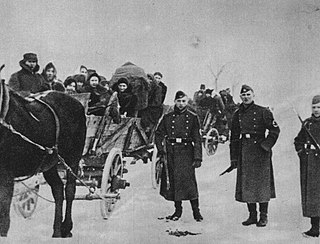
Belzec was a Nazi German extermination camp built by the SS for the purpose of implementing the secretive Operation Reinhard, the plan to murder all Polish Jews, a major part of the "Final Solution" which in total entailed the murder of about 6 million Jews in the Holocaust. The camp operated from 17 March 1942 to the end of June 1943. It was situated about 500 m (1,600 ft) south of the local railroad station of Bełżec, in the new Lublin District of the General Government territory of German-occupied Poland. The burning of exhumed corpses on five open-air grids and bone crushing continued until March 1943.
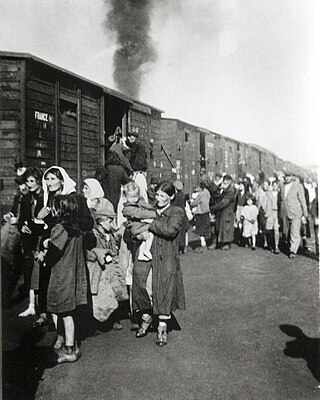
Operation Reinhard or Operation Reinhardt was the codename of the secret German plan in World War II to exterminate Polish Jews in the General Government district of German-occupied Poland. This deadliest phase of the Holocaust was marked by the introduction of extermination camps.

Maly Trostenets is a village near Minsk in Belarus, formerly the Byelorussian Soviet Socialist Republic. During Nazi Germany's occupation of the area during World War II, the village became the location of a Nazi extermination site.

Odilo Lothar Ludwig Globocnik was an Austrian Nazi and a perpetrator of the Holocaust. He was an official of the Nazi Party and later a high-ranking leader of the SS. Globocnik had a leading role in Operation Reinhard, the organized murder of around one and a half million Jews, of mostly Polish origin, during the Holocaust in the Majdanek, Treblinka, Sobibor and Belzec extermination camps. Historian Michael Allen described him as "the vilest individual in the vilest organization ever known". Globocnik took his own life shortly after his capture and detention by British soldiers.
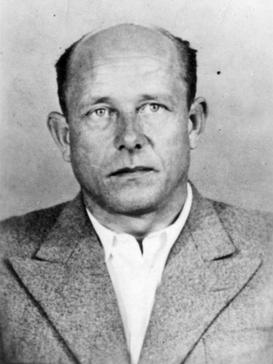
Hermann Julius Höfle, also Hans (or) Hermann Hoefle (, was an Austrian-born SS commander and Holocaust perpetrator during the Nazi era. He was deputy to Odilo Globočnik in the Aktion Reinhard program, serving as his main deportation and extermination expert. Arrested in 1961 in connection with these crimes, Höfle committed suicide by hanging in prison before he was tried.
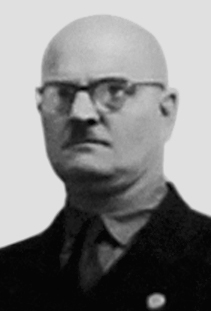
Christian Wirth was a German SS officer and leading Holocaust perpetrator who was one of the primary architects of the program to exterminate the Jewish people of Poland, known as Operation Reinhard. His nicknames included Christian the Cruel, Stuka, and The Wild Christian due to the extremity of his behaviour among the SS and Trawniki guards and to the camp inmates and victims.

Ferdinand von Sammern-Frankenegg was an Austrian SS functionary during the Nazi era. He was born in Grieskirchen. Von Sammern-Frankenegg served in World War I as a member of the Kaiserschützen, then of the K.u.k. Feldjäger and then after Austria-Hungary had formally surrendered, in the German Freikorps Oberland and the Steirischer Heimatschutz. Ferdinand von Sammern-Frankenegg earned his PhD in legal studies at the University of Innsbruck in 1922. He had been a member of the dueling fraternity Universitätssängerschaft Skalden zu Innsbruck. Von Sammern-Frankenegg worked as a lawyer in Peuerbach.

Sonderaktion1005, also called Aktion1005 or Enterdungsaktion, was a top-secret Nazi operation conducted from June 1942 to late 1944. The goal of the project was to hide or destroy any evidence of the mass murder that had taken place under Operation Reinhard, the attempted extermination of all Jews in the General Government occupied zone of Poland. Groups of Sonderkommando prisoners, officially called Leichenkommandos, were forced to exhume mass graves and burn the bodies; inmates were often put in chains to prevent them from escaping.

Erwin Hermann Lambert was a perpetrator of the Holocaust. In profession, he was a master mason, building trades foreman, Nazi Party member and member of the Schutzstaffel with the rank of SS-Unterscharführer (corporal). He supervised construction of the gas chambers for the Action T4 euthanasia program at Hartheim, Sonnenstein, Bernburg and Hadamar, and then at Sobibór and Treblinka extermination camps during Operation Reinhard. He specialized in building larger gas chambers that killed more people than previous efforts in the extermination program.
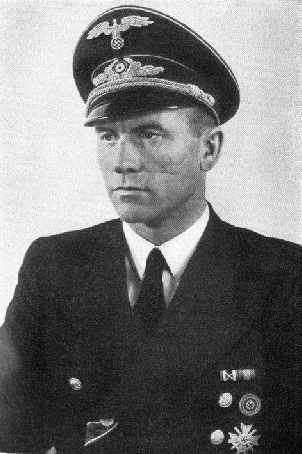
Albert Ganzenmüller was a German Nazi and, as the Under-secretary of State at the Reich Transport Ministry (Reichsverkehrsministerium), was involved in the deportation of German Jews.
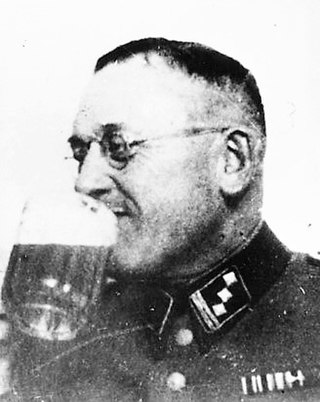
Gottlieb Hering was an SS commander of Nazi Germany. He served in Action T4 and later as the second and last commandant of Bełżec extermination camp during Operation Reinhard. Hering directly perpetrated the genocide of Jews and other peoples during The Holocaust.
Ernst Stengelin was a German SS-Unterscharführer (Corporal) who served at Treblinka and Sobibor extermination camps and was killed in the Sobibor uprising. Nothing is known about his personal life.
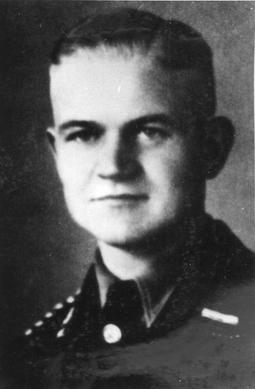
Herbert Floss or Herbert Floß was an SS functionary of Nazi Germany who served as acting commander of the Sobibor extermination camp during the Holocaust in Poland. He also served as cremation expert in Camp II Totenlager at the Treblinka extermination camp.

The Belzec trial in the mid-1960s was a war crimes trial of eight former SS members of Bełżec extermination camp. The trial was held at the 1st Munich District Court and should be seen in the context of the Sobibor trial, which followed the Belzec trial, because five of the defendants were accused in both trials. In addition, the Belzec and Sobibor trials, along with the Treblinka trials, form a body of evidence of the crimes of mass extermination as part of the so-called Action Reinhardt programme - the killing of over two million Jews and 50,000 Roma and Sinti. These trials are directly related to the mass murder of 100,000 people in the official Nazi Euthanasia programme known after the war as Action T4, as many of the security guards worked in the euthanasia centres before transferring to the extermination camps. The first Euthanasia trials were carried out shortly after the war.

Franz Suchomel was a Sudeten German Nazi war criminal. He participated in the Action T4 euthanasia program, in Operation Reinhard, and the Einsatzgruppen actions in the Adriatic operational zone. He was convicted at the Treblinka trials in September 1965 and spent four years in prison.
Der Ort des Terrors is a nine-volume German-language encyclopedia series of the Nazi concentration camps and subcamps, published between 2005 and 2009. The first volume centers around the Nazi concentration camps and volumes 2-7 focuses on the 20+ main camps and approximately 1,000 subordinate camps.

During the Holocaust, 99% of the Jews from Lublin District in the General Governorate of German-occupied Poland were murdered, along with thousands of Jews who had been deported to Lublin from elsewhere. There were three extermination camps in Lublin District, Sobibor, Belzec, and Majdanek.

Dieter Pohl is a German historian and author who specialises in the Eastern European history and the history of mass violence in the 20th century.
References
- ↑ "Stephan Lehnstaedt". beta.clio-online.de (in German). 2022-12-04. Retrieved 2022-12-04.
- ↑ WELT (2022-01-20). "WELT-Gespräch: Prof. Stephan Lehnstaedt zur Wannseekonferenz am 20. Januar 1942". DIE WELT (in German). Retrieved 2022-12-04.
- ↑ Datel, Edward. "Prof. Dr. Stephan Lehnstaedt | Touro College Berlin | American College | Business | Psychology". TOURO COLLEGE BERLIN. Retrieved 2022-12-04.
- ↑ "Special exhibitions". Wannsee-Konferenz Relaunch. Retrieved 2022-12-04.
- ↑ "Ausstellungen | Interventionen | MHM Berlin-Gatow". www.mhm-gatow.de. Retrieved 2022-12-04.
- ↑ "Rezension zu: S. Lehnstaedt: Imperiale Polenpolitik". H-Soz-Kult. Kommunikation und Fachinformation für die Geschichtswissenschaften (in German). 2017. ISBN 9783944870571 . Retrieved 11 March 2020.
- ↑ https://www.pol-int.org/en/node/6022?language=de . Retrieved 11 March 2020.
{{cite web}}: Missing or empty|title=(help) - ↑ Kay, Alex J. (5 October 2018). "Stephan Lehnstaedt, Der Kern des Holocaust. Bełżec, Sobibór, Treblinka und die Aktion Reinhardt. München, Beck 2017". Historische Zeitschrift. 307 (2): 579–580. doi:10.1515/hzhz-2018-1479. S2CID 165999445.
- ↑ Schmittwilken, Christian (2017). "Rezension von: Der Kern des Holocaust". sehepunkte . 17 (9).
- ↑ Friedrich, Klaus-Peter (2 June 2012). "Okkupation im Osten: Besatzeralltag in Warschau und Minsk 1939-1944 [Occupation in the East: The Occupiers' Everyday Life in Warsaw and Minsk, 1939-1944] (review)". Shofar: An Interdisciplinary Journal of Jewish Studies. 30 (2): 157–160. doi:10.1353/sho.2012.0067. ISSN 1534-5165. S2CID 171039314.
- ↑ Epstein, C. (4 April 2012). "Okkupation im Osten: Besatzeralltag in Warschau und Minsk 1939-1944, Stephan Lehnstaedt (Munich: R. Oldenbourg, 2010), 381 pp., cloth, 54.80". Holocaust and Genocide Studies. 26 (1): 133–136. doi:10.1093/hgs/dcs016.
- ↑ H-War review